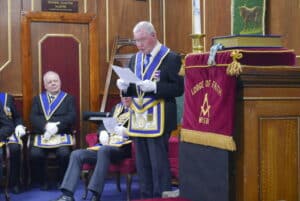Reflections on the Closure of a Storied Lodge: The Assistant Provincial Grand Master’s Perspective
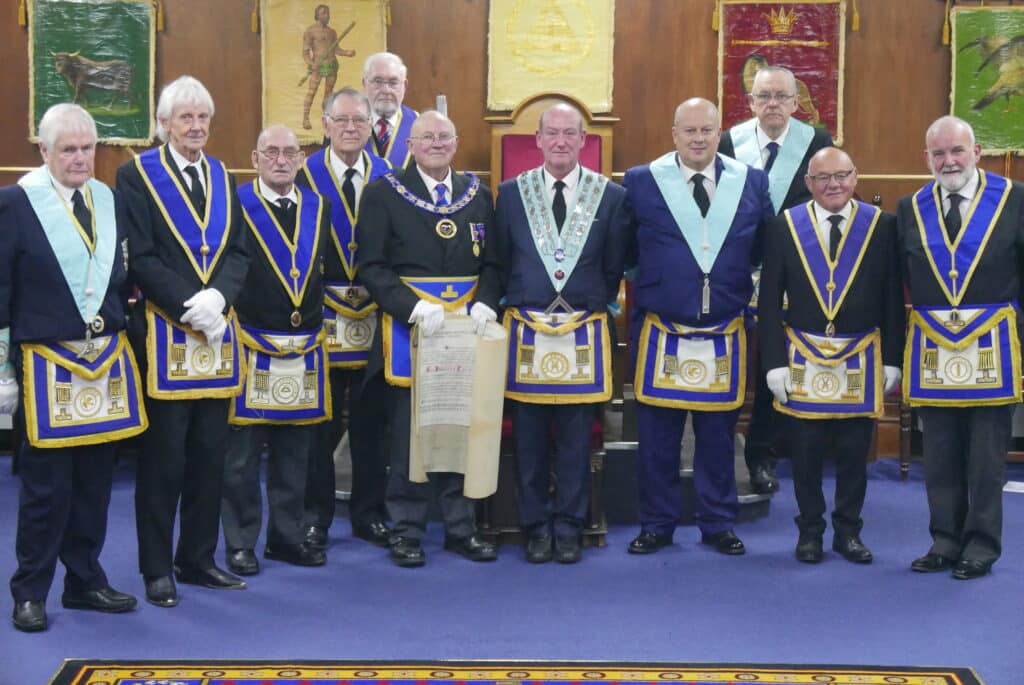
The Assistant Provincial Grand Master, The Revd Canon Richard Hawkins, shared his thoughts on the occasion of the Lodge of Faith’s closing. “There is always understandable sorrow at the closure of a Lodge,” he began, acknowledging the emotional weight of such an event.
The Significance of a Name
Canon Hawkins expressed curiosity about the origins and naming of lodges, noting that these details often remain unexplored in lodge histories. Despite the lack of documentation regarding the founding of the Lodge of Faith, his research revealed a rich lineage: “You are one of 10 Lodges in this Constitution named Lodge of Faith, but not the oldest.” He traced the legacy to the oldest Lodge of Faith 141, established in 1744 in London, and recognised the others that followed, marking the Lodge of Faith as a venerable institution within the brotherhood.
Legacy of the Lodge and its Progeny
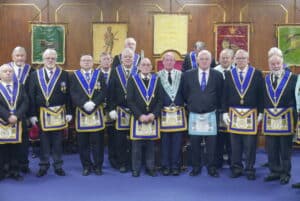
Members of Daughter and Grand-Daughter lodges in attendance.
The Lodge of Faith did not stand alone but was a progenitor of a family of lodges. It founded three daughter lodges, Townley Parker and Ardwick, which continue to thrive, and Fidelitas, which closed in 2003. Furthermore, it has six granddaughters, with lodges like Iron Road, Fraternity, and Elizabethan still active, while others have closed their doors. The Canon pointed out the transitions and closures, including the transformation of Silver Jubilee into Acacia Jubilee, which was eventually erased in 2013.
Historical Accounts and Membership
Delving into the archives, Canon Hawkins unearthed articles from The Freemasons’ Chronicle, painting a vivid picture of the lodge’s activities in the 1880s. He recounted the expulsion of members for non-payment of dues and the bustling activity of meetings, initiations, and elections.
The lodge’s membership peaked at 98 in 1950, a post-war era of Masonic growth. Notably, the lodge was fortunate not to lose any members to the Second World War, a fact that underscores the peace of that period.
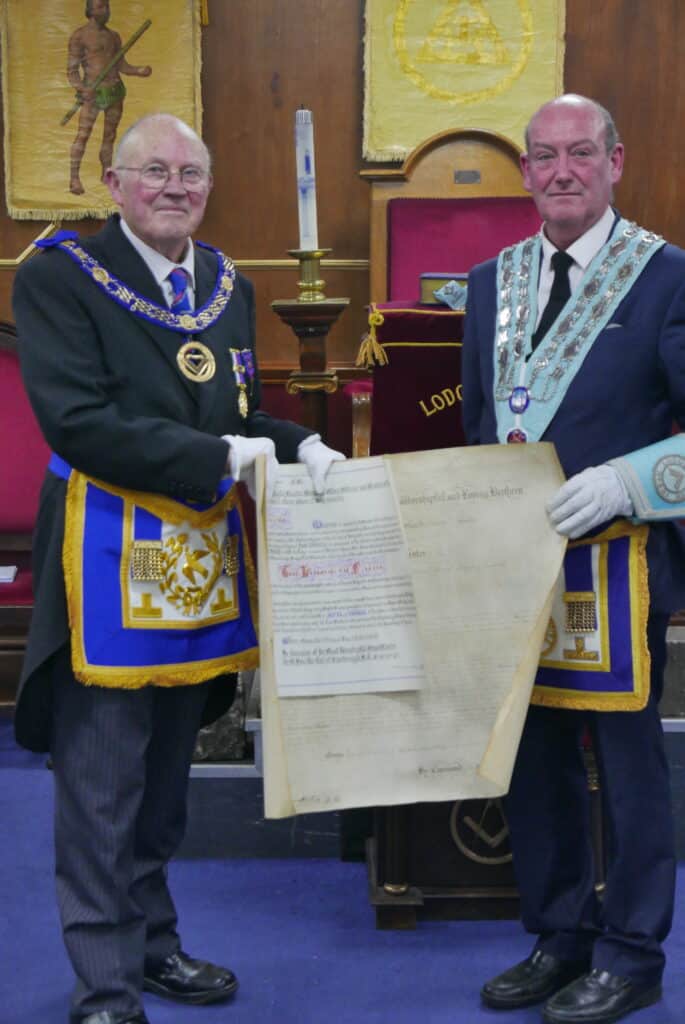
Charitable Endeavors and Community Support
The Assistant Provincial Grand Master highlighted the Lodge of Faith’s longstanding commitment to charity. The generous contributions, such as the 100 guineas towards the construction of the hall on Bridge Street and the 5 guineas for the Bronze doors at Great Queen Street, were significant for their time and continue to be impactful today.
The lodge’s care for its members and their families was also emphasised. He recounted an 1862 incident where the lodge provided monetary support to a brother in need and celebrated the ongoing tradition of gifting to the widows during Christmas, illustrating the lodge’s deep-rooted benevolence.
A Call to Continue the Legacy
In the wake of the lodge’s closing, the APGM called upon the brethren to persist in their philanthropic spirit, urging them to consider a donation to the Festival to support the Masonic Charitable Foundation. This foundation assists disadvantaged masons, thus ensuring that the Lodge of Faith’s legacy of brotherhood and generosity endures. He also thanked WBro Dave Williamson for sending him a copy of the Lodge history from 1851 to 2001, mentioning that it was expertly put together by WBro Peter Bibby. The main points covered in the presentation follow.
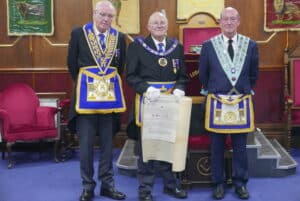
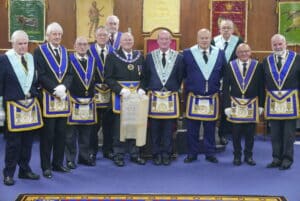

The Legacy of the Lodge of Faith: A Reflection of Manchester’s Industrial Heritage
In the heart of Manchester’s vibrant history, there lies a tale as old as the Industrial Revolution itself — the story of the Lodge of Faith. This lodge, now steeped in the annals of time, was not an ordinary gathering. It was a confluence of minds and talent, a testament to the city’s engineering prowess and social fabric.
The Early Days and Notable Members
Formed by a handful of members from the Caledonia Lodge No. 204, the Lodge of Faith bore the number 847 at its inception. Consecrated on the 23rd of May, 1851, a Friday, its first meeting was held in a room above the New Inn Openshaw, a location lost to the sands of time.
This location was perhaps a beacon that drew in Manchester’s engineering elite, the creme de la creme of the industrial world. Richard Peacock of Beyer, Peacock and Company, John Ashbury, a railway carriage and wagon builder with a station named after him, George Saxon (of Saxons Engineers Manufacturer of Stationary Mill Steam Engines) and Peter Mather of the Engineering Firm Mather and Platt) were just a few of the illustrious founders. They were engineers, innovators, and, by the standards of the time, quite wealthy.
Changes and Milestones
It’s recorded that on the 15th of July, 1863, the lodge’s number changed from 847 to 581, though history has left us no reason for this shift. During that era, Brother Greenup joined, beginning a dynasty that would leave a lasting legacy on the lodge, particularly through their printing services in Droylsden.
The late 19th and early 20th centuries brought more than just numbers and names to the Lodge of Faith. On May 19th, 1891, Charles Wright donated a grave in the Southern Cemetery to the lodge, ensuring a resting place for the brethren. The lodge also moved locations multiple times, finally contributing to the construction of the Masonic Temple at Bridge Street after the First World War, marking a new era in its history.
Cultural Contributions and the Modern Era
The lodge moved location several times, but in common with most other lodges at that time, met in rooms over a public house or hotel. Following the First World War, it was decided to build the Masonic temple at Bridge Street in Manchester. The lodge contributed to the constriction cost and on 18th September 1929 held its first meeting there in the Sykes Suite. On 25th May 1921 the “Kirkwell Scroll” was presented to the Lodge by Bro. W. Mundell. 1931 18th February. A letter from Province was received thanking the Lodge for the donations for the Museum. They donated: a framed copy of “The Kirkwell Scroll” with an explanation. A Small Key Stone made from stone taken from King Solomon’s Mine in Jerusalem. These items are now on display in the lodge rooms in Stanley House.
The contrast between the lodge’s heyday and the present day is stark. In 1959, due to its large membership, there was a motion to appoint “sick visitors” to aid the Almoner, showcasing the lodge’s community spirit and care for its members.
The Changing Times
W Bro Eric Lord, in 1983, became the first master to serve two consecutive years — a harbinger of the changing times and perhaps of changes yet to come. Ironically, it was on February 1st that the lodge first met at Stanley House, and it is on this date that the Lodge of Faith would meet there for the last time.
A Legacy to Cherish
As we reflect on the journey of the Lodge of Faith, from its inception among Manchester’s industrial elite to its enduring legacy, we see more than just a fraternity. We see a microcosm of Manchester’s own transformation, a narrative woven into the city’s very fabric. It’s a story of community, innovation, and adaptability — values that resonate with us even as we forge ahead into the future.
This narrative is not just an homage to the Lodge of Faith but an echo of Manchester’s industrial spirit that shaped the world. Let us carry forward the torch of those who laid the foundations of our community with the same commitment to fraternity and progress.
